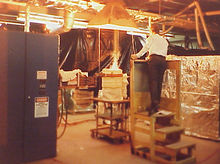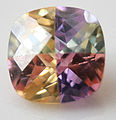- Cubic zirconia
-
 A round brilliant-cut cubic zirconia
A round brilliant-cut cubic zirconiaCubic zirconia (or CZ) is the cubic crystalline form of zirconium dioxide (ZrO2). The synthesized material is hard, optically flawless and usually colorless, but may be made in a variety of different colors. It should not be confused with zircon, which is a zirconium silicate (ZrSiO4). It is sometimes erroneously called "cubic zirconium".
Because of its low cost, durability, and close visual likeness to diamond, synthetic cubic zirconia has remained the most gemologically and economically important competitor for diamonds since commercial production began in 1976. Its main competitor as a synthetic gemstone is the more recently cultivated material, synthetic moissanite.
Contents
Technical aspects
Cubic zirconia is crystallographically isometric, an important attribute of a would-be diamond simulant. During synthesis zirconium oxide would naturally form monoclinic crystals, its stable form under normal atmospheric conditions. A stabilizer is required for cubic crystals to form, and remain stable at ordinary temperatures; this may be typically either yttrium or calcium oxide, the amount of stabilizer used depending on the many recipes of individual manufacturers. Therefore the physical and optical properties of synthesized CZ vary, all values being ranges.
It is a dense substance, with a specific gravity between 5.6 and 6.0 — at least 1.6 times that of diamond. Cubic zirconia is relatively hard, at about 8 on the Mohs scale— slightly harder than most semi-precious natural gems.[1] Its refractive index is high at 2.15–2.18 (compared to 2.42 for diamonds) and its luster is adamantine. Its dispersion is very high at 0.058–0.066, exceeding that of diamond (0.044). Cubic zirconia has no cleavage and exhibits a conchoidal fracture. Because of its high hardness, it is generally considered brittle.
Under shortwave UV cubic zirconia typically fluoresces a yellow, greenish yellow or "beige". Under longwave UV the effect is greatly diminished, with a whitish glow sometimes being seen. Colored stones may show a strong, complex rare earth absorption spectrum.
History
Discovered in 1892, the yellowish monoclinic mineral baddeleyite is a natural form of zirconium oxide.
The extremely high melting point of zirconia of 2750°C (4976°F) makes the controlled growth of single crystals difficult, as no existing crucible could hold the material in its molten state. However, stabilization of cubic zirconium oxide had been realized early on, with the synthetic product stabilized zirconia introduced in 1930. Although cubic, it was in the form of a polycrystalline ceramic: it was used as a refractory material, highly resistant to chemical and thermal (up to 2540°C or 4604°F) attack.
In 1899, German mineralogists M. V. Stackelberg and K. Chudoba discovered naturally occurring cubic zirconia in the form of microscopic grains included in metamict zircon. This was thought to be a byproduct of the metamictization process, but the two scientists did not think the mineral important enough to give it a formal name. The discovery was confirmed through X-ray diffraction, proving the existence of a natural counterpart to the synthetic product.
As with the majority of grown diamond substitutes, the idea of producing single-crystal cubic zirconia arose in the minds of scientists seeking a new and versatile material for use in lasers and other optical applications. Its production eventually exceeded that of earlier synthetics, such as synthetic strontium titanate, synthetic rutile, YAG (yttrium aluminium garnet) and GGG (gadolinium gallium garnet).
Some of the earliest research into controlled single-crystal growth of cubic zirconia occurred in 1960s France, much work being done by Y. Roulin and R. Collongues. This technique involved molten zirconia being contained within a thin shell of still-solid zirconia, with crystal growth from the melt: The process was named cold crucible, an allusion to the system of water cooling used. Though promising, these attempts yielded only small crystals.
Later, Soviet scientists under V. V. Osiko at the Lebedev Physical Institute in Moscow perfected the technique, which was then named skull crucible (an allusion either to the shape of the water-cooled container or to the form of crystals sometimes grown). They named the jewel Fianit after the institute's name FIAN (Physical Institute of the Academy of Science), but the name was not used outside of the USSR. Their breakthrough was published in 1973, and commercial production began in 1976. By 1980 annual global production had reached 50 million carats (10 tonnes).
Because the natural form of cubic zirconia is so rare, all cubic zirconia used in jewelry has been synthesized, or created by humans.
Synthesis
The Soviet-perfected skull crucible is still used today, with little variation. Water-filled copper pipes provide a cup-shaped scaffold in which the zirconia feed powder is packed, the whole contraption being wrapped with radio frequency induction coils running perpendicular to the copper pipes. A stabilizer, typically calcium oxide, is mixed with the feed powder.
The RF induction coils function in a manner similar to the primary winding in a transformer. The zirconia acts as the "secondary winding" of a transformer which in effect is "shorted" out and thus gets hot. This heating method requires the introduction of small pieces of zirconium metal. The metal is placed near the outside of the charge and is melted by the RF coils and heats the surrounding zirconia powder from the outside inwards. The cooling water-filled pipes embracing the outer surface maintain a thin "skin" (1–2 mm) of unmelted feed, creating a self-contained apparatus. After several hours the temperature is reduced in a controlled and gradual manner, resulting in the formation of flawless columnar crystals. Prolonged annealing at 1400°C is then carried out to remove any strain. The annealed crystals, which are typically 5 cm long by 2.5 cm wide (although they may be grown much larger), are then cut into gemstones.
The addition of certain metal oxide dopants into the feed powder results in a variety of colors. For example:
Dopant Color(s) Cerium yellow orange red Chromium green Neodymium purple Erbium pink Titanium golden brown Innovations
In recent years manufacturers have sought ways of distinguishing their product by supposedly "improving" cubic zirconia. Coating finished CZs in a film of diamond-like carbon (DLC) or Amorphous Diamond is one such innovation, a process using chemical vapor deposition. The resulting material is purportedly harder, more lustrous and more like diamond overall. The coating is thought to quench the excess fire of CZ, while improving its refractive index, thus making it appear more like diamond. Additionally, because of the high percentage of diamond bonds in the amorphous diamond coating, the finished simulant will show a positive diamond signature under Raman spectroscopy.
Another technique first applied to quartz and topaz has also been adapted to cubic zirconia: vacuum-sputtering an extremely thin layer of metal oxide (typically gold) on to the finished stones creates an iridescent effect.[2] This material is marketed as "mystic" by many dealers. Unlike DLC, the effect is not permanent, as abrasion easily removes the oxide layer.
Cubic zirconia versus diamond
There are a few key features of cubic zirconia which distinguish it from diamond:
- Dispersion: With a dispersive power greater than diamond (0.060 vs. 0.044) the fire of cubic zirconia is more prismatic.[citation needed]
- Hardness: Cubic zirconia has a rating of approximately 8 on Mohs hardness scale vs. a rating of 10 for diamonds.[3]
- Specific gravity: a cubic zirconia will weigh about 1.7 times more than a diamond of the same size.
- Flaws: Contemporary production of cubic zirconia is virtually flawless,[citation needed] whereas most diamonds have some sort of defect, be it a feather, included crystal, or perhaps a remnant of an original crystal face (e.g. trigons).[citation needed]
- Refractive index: Cubic zirconia has a refractive index of 2.176, compared to a diamond's 2.417.
- Cut: Some cubic zirconia gemstones are cut with facet shapes that differ from those typically used for diamonds. This difference would be visible under close inspection with a loupe. However, many are cut in the same way that diamonds are cut.
- Color: Only the rarest of diamonds are truly colorless, most having a tinge of yellow or brown to some extent. By comparison, cubic zirconia often is entirely colorless: equivalent to a perfect "D" on diamond's color grading scale. However, some sellers offer near colorless or yellow cubic zirconia, along with other colors, such as pink, green, etc.
- Thermal conductivity: Cubic zirconias are thermal insulators while diamonds are among the most efficient thermal conductors, exceeding silver's thermal conductivity. This makes telling the difference between diamond and cubic zirconia quite easy for those with the right instruments.
See also
References
- ^ "Mohs' Hardness of Abrasives". http://www.reade.com/resources/reference-charts-particle-property-briefings/851-mohs-hardness-of-abrasives. Retrieved 2009-06-06.
- ^ "Designer Enhanced Gemstones". Azotic Coating Technology, Inc. 2010. http://azotic.us/gems.php. Retrieved 3 November 2010.
- ^ "Mohs' Hardness of Abrasives". http://www.reade.com/resources/reference-charts-particle-property-briefings/851-mohs-hardness-of-abrasives. Retrieved 2009-06-06.
Further reading
- Nassau, Kurt (1980). Gems Made by Man. ISBN 0-8019-6773-2.
Categories:- Diamond simulants
- Gemstones
- Refractory materials
- Synthetic minerals
- Zirconium compounds
Wikimedia Foundation. 2010.




